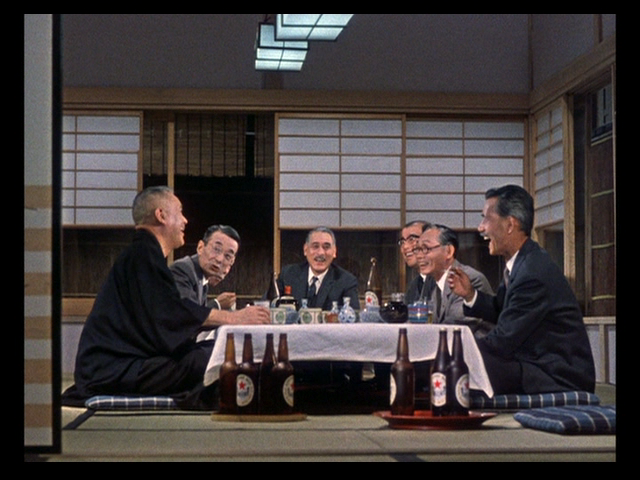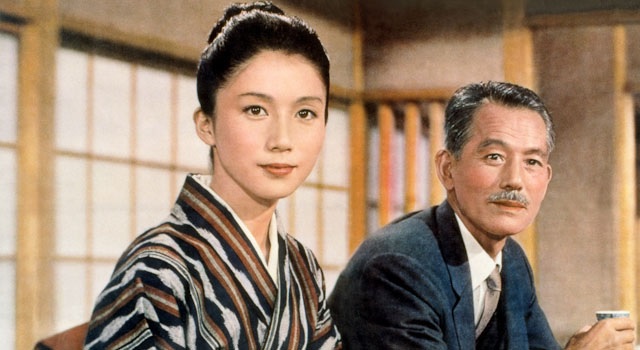 Ozu makes quiet films that steal on you in subtle ways and leave an impression that deepens over time. At first glance An Autumn Afternoon (1962), now digitally restored by Shochiku Studios with a crisp clear print, can seem like a slow film where nothing much happens. The story concerns a widower and father Hirayama (Ozu regular Chishu Ryu who gives an intelligent and nuanced performance) who has an encounter with an old teacher Sakuma (nicknamed ‘the Gourd) (Eijirô Tôn0 who deals well with Ozu’s suddent shifts of mood) that challenges his views of his previously comfortable domestic situation living with his daughter Michiko (Shima Iwashita) and son Koichi (Keiji Sada). He discovers that Sakuma is now living a lonely life with his spinster daughter running a second rate noodle restaurant, and Sakuma warns him to marry off his young daughter Michiko before it’s too late and her life is ruined like his daughter’s. This prompts Hirayama to interview Michiko’s preferred suitor, only to discover that he is already engaged, he then sets about finding her another suitable suitor.
Ozu makes quiet films that steal on you in subtle ways and leave an impression that deepens over time. At first glance An Autumn Afternoon (1962), now digitally restored by Shochiku Studios with a crisp clear print, can seem like a slow film where nothing much happens. The story concerns a widower and father Hirayama (Ozu regular Chishu Ryu who gives an intelligent and nuanced performance) who has an encounter with an old teacher Sakuma (nicknamed ‘the Gourd) (Eijirô Tôn0 who deals well with Ozu’s suddent shifts of mood) that challenges his views of his previously comfortable domestic situation living with his daughter Michiko (Shima Iwashita) and son Koichi (Keiji Sada). He discovers that Sakuma is now living a lonely life with his spinster daughter running a second rate noodle restaurant, and Sakuma warns him to marry off his young daughter Michiko before it’s too late and her life is ruined like his daughter’s. This prompts Hirayama to interview Michiko’s preferred suitor, only to discover that he is already engaged, he then sets about finding her another suitable suitor.
It is a simple domestic story but one which contains important and resonant themes revolving around family, mortality and old age, tradition versus modernity and loneliness. Themes that Ozu has used in varying ways throughout his films. And Ozu is a master at conveying so much in a few gestures from his actors or in a few symbolic shots. For example conveying the sadness of Michiko on learning her preferred suitor is engaged, Ozu shows her aimlessly wrapping a tape measure around her hands showing the unexpected twists and turns of life. Ozu also manages to make scenes suddenly change mood in a way that conveys the complexity of life, showing for example in one scene Sakamoto humorously staggering in home drunk on sake and then showing his daughter’s (Kuniko Miyake who makes a big impression in the small screen time she has) upset and tearful reaction as we see how she must’ve dealt with this on far too many occasions, it also testament to the actors involved that they are able to deal with these shifts of mood with ease.
We also get a sense of post-war Japan still ironically clinging to its military pride, through the military march that is requested andplayed in the bar that Hirayama, an ex-Naval officer frequents with an old comrade in war Sakamoto. We see the ridiculousness of war nostalgia and also how the Japanese deal with defeat through playfulness as the characters joke about scenarios in which they’ve won the war. We also see the tension between a Japan that is industrial (evoked by the shots of many smoking chimneys) and full of the latest products such as fridges and hoovers (Hirayama’s eldest son’s wife Akiko insists on getting a fridge because the neighbours have one), and even virility pills (a recurring joke in the film is an old friend of Hirayama’s has to use these to keep up with his young wife, and it certainly paints Ozu as being very ahead of his time and more risqué than one would expect), and which has women in the workplace (albeit in secretarial roles).
The female characters like Michiko and Akiko (the striking and charismatic Mariko Okada, familiar from her role in Ozu’s Late Autumn (1960)) are also refreshingly and pleasingly far from submissive and frequently feistily resist being told what to do by men (“do it yourself” is a common reply), and we often see them ordering the men about and appearing stronger. Whilst on the other hand arranged marriages are still the norm and readily accepted by women such as Michiko. And so Ozu presents to us Japanese city life as full of contradictions and irony, contradictions which Ozu’s films thrive on and make good use of.
being told what to do by men (“do it yourself” is a common reply), and we often see them ordering the men about and appearing stronger. Whilst on the other hand arranged marriages are still the norm and readily accepted by women such as Michiko. And so Ozu presents to us Japanese city life as full of contradictions and irony, contradictions which Ozu’s films thrive on and make good use of.
His sixth film made in colour also shows the delight that Ozu takes in this new aesthetic, picking out primary colours in muted backgrounds, such as the bright reds of the local bar’s furniture, and shows his ready ability to employ colour to striking effect. His use of shots showing empty rooms and passages also conveys the loneliness and transience of the character’s lives well, while the use of the same limited locations gives a sense of the cyclical, self-contained nature of his character’s lives who visit the same bars, restaurants and office spaces. So if you’re looking for a grand spectacle you will be profoundly disappointed, but if on the other hand you are looking for a profound insight into human relations and social structures you can’t go far wrong with this film.




